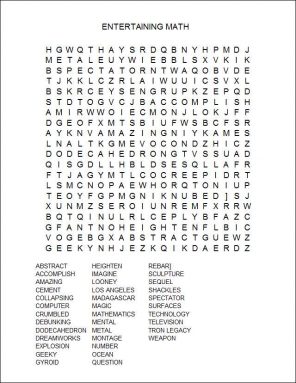Cool Jobs: Math as entertainment
Magic, movies and metal: How mathematics adds dazzle to the visual world
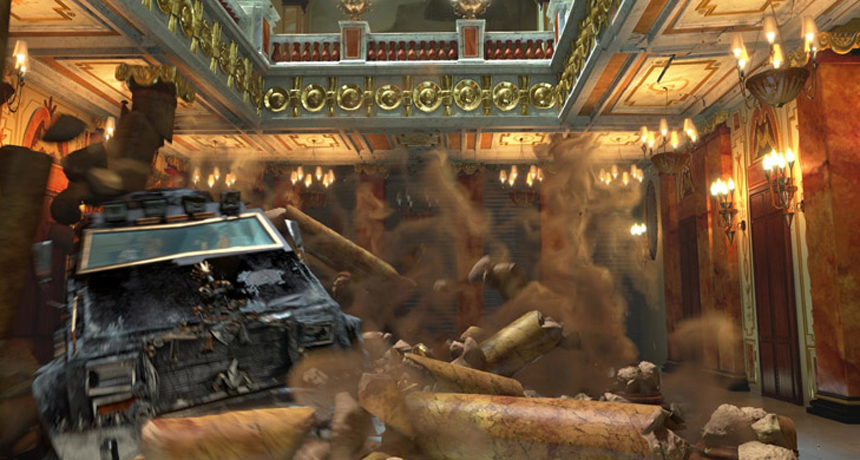
When a band of zoo buddies tears through a Monte Carlo casino, the marble columns don’t have a chance. Nafees Bin Zafar used mathematics to power the visual effects behind this madcap scene in Madagascar 3.
Madagascar 3” © 2012 DreamWorks Animation LLC, used with permission of DreamWorks Animation LLC
“I seem to specialize in the area of mayhem,” says Nafees Bin Zafar with a smile. This visual effects expert helps bring some of the most memorable smashes, crashes and dashes to the movie screen. The one in Madagascar 3 where the fearless heroes flee a casino, leaving all sorts of rubble in their wake? Check. The scene in 2012 where Los Angeles slides into the Pacific Ocean? Check. The light cycle chase scenes in Tron: Legacy? Check.
At DreamWorks Animation (and previously at another company called Digital Domain) Bin Zafar creates software used to make the special effects in motion pictures — and sometimes cartoons — look as realistic as possible. Often he works with the skimpiest of instructions. “For 2012,” he recalls, “all we really had was one line in the script: ‘And then California sinks into the ocean.’” Bin Zafar and a team of nine other programmers and animators took that one line and turned it into a five-minute montage of falling buildings, collapsing freeways and enormous cracks splitting Earth.
To make all this fakery look real, it has to act real. “We have to make this stuff behave correctly,” Bin Zafar explains. Take the tumbling skyscrapers in 2012: Bin Zafar asked himself, “What would the materials have been made from?” That question generated a list that included glass, cement, steel girders and rebar. It also sparked more questions.
“Do we know the math of how this stuff bends and flexes and shakes around?” Bin Zafar asks. “It turned out that we didn’t.”
Bin Zafar eventually solved that math problem along the way to helping create some cutting-edge visual effects. He’s just one of three experts profiled in this article who rely on math to entertain — and amaze.
How to realistically destroy a fake building
To compute how a virtual building should collapse on-screen in a convincingly real way, Bin Zafar uses engineering, computer skills and a toy familiar to most kids. Yes, he starts by pretending the building is made of Lego bricks connected by springs. (He actually keeps a box of Legos — the regular kind without springs — in his office for inspiration.) The virtual Legos form the large chunks into which the building crumbles, while the virtual springs simulate the forces that would act on the building. Once the building starts to collapse, Bin Zafar then ensures that the thousands of computer-drawn pieces fall in a realistic way, without their passing through each other — something that would immediately spoil the illusion of reality.
Although Bin Zafar instructs his computer program to apply the laws of physics in most instances, he also knows when to bend them. This was especially true in Madagascar 3. “We do things like change gravity’s direction all the time,” Bin Zafar says. “In a cartoon,” he explains, “it’s quite reasonable for a character to start walking up a wall — and yet have everything look natural.”
As a kid, Bin Zafar was a big fan of cartoons and movies. “Looney Tunes were my favorites,” he recalls. He also loved the original Tron, a movie that came out in 1982. Watching it “was the first time I realized, as a child, that the things you see in a movie didn’t have to be real.” Imagine his thrill at being asked to work on the film’s sequel, 28 years later.
Bin Zafar points to two important skills he has needed to work in a digital movie studio: communicating effectively and solving word puzzles.
Communication is critical because creating visual effects is a team job. When Bin Zafar writes a computer program, he also has to explain the program to the animators who use it. “My work makes things look believable, but it really takes an artist to make things look spectacular,” he says.
Solving word problems is almost as important, Bin Zafar notes, because requests are never described in numerical terms. Instead he gets: “And then Los Angeles sinks into the ocean.” It’s his job to translate that request into the language of mathematics, so that a computer can render it into believable images.
In the exciting environment in which Bin Zafar works, the distinctions between artist and mathematician often blur: Artists need to understand math and the mathematicians need to understand art. Says Bin Zafar: “We’re all exploring our imaginations together.”
Sculpting geometry
While studying mathematics at Yale University, Bathsheba Grossman also took a few art courses. But one day in her senior year, Grossman visited the studio of Erwin Hauer, an artist she considers “one of the great geometric sculptors of the 20th century.” (Geometry is the mathematics of shapes, especially points, lines, flat planes, curves and surfaces.)
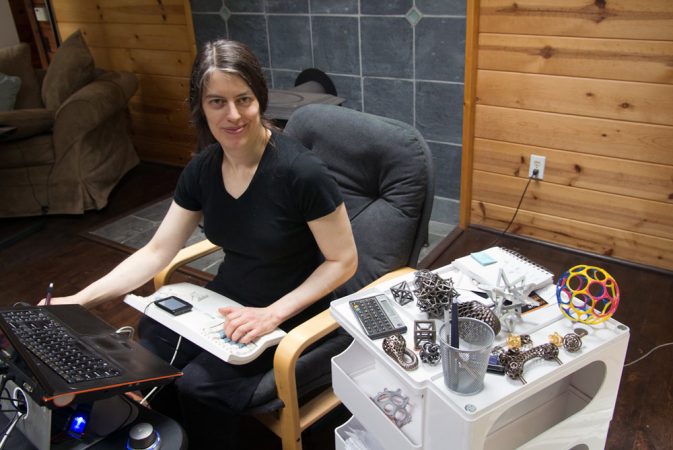
Grossman found Hauer’s studio full of elaborately curved shapes called minimal surfaces. Mathematicians are interested in minimal surfaces because they have no peaks, valleys or folds that would increase their surface area. Want to make one? Dip a loop of wire into a bucket of suds and then pull it out. The shape formed by the soap film is a minimal surface. Cleverly, Hauer used these kinds of shapes to make art. “I had no idea you could do such a thing,” says Grossman.
Inspired, Grossman began sculpting too. Today, 16 years later, she creates abstract sculptures that are as geometrical as they are artistic. She first creates virtual, three-dimensional models on the computer. Only later does she turn those into physical sculptures. Some baffle the eyes. How do they hold together?
Science lovers are among Grossman’s biggest fans. “I’m, like, geek famous,” she says. Grossman does not exhibit her work in traditional art galleries. Instead, she connects with buyers through word of mouth, write-ups in magazines such as Discover and Wired and, more than anything else, the Internet.
The Internet is one of two contemporary technologies that have made Grossman’s career possible. The other is three-dimensional printing. This process transforms virtual models created on a computer into actual objects you can hold in your hands. A 3-D printer is like an ink-jet printer, only better. An ink-jet printer squirts a dot of ink into each flat square, or “cell,” of a two-dimensional image. A 3-D printer, meanwhile, injects a little blob of plastic, metal or other material into each little three-dimensional cell that makes up a solid object. It’s the difference between printing a tic-tac-toe grid in 2-D and a Rubik’s Cube in 3-D.
The first 3-D printers created only plastic models. Around 2005, more advanced printers that work with metal started to appear. They opened up new possibilities for Grossman.
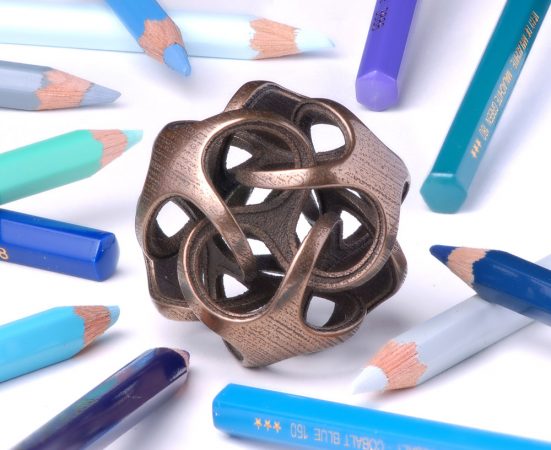
For thousands of years, the only way to produce multiple, identical copies of a metal object (such as a doorknob) was to make a cast. “This was the great technological breakthrough of the Bronze Age and it still serves us well today, but it comes with built-in limits,” Grossman says. That is because only simple shapes can be cast from reusable molds.
For more complex shapes, like Grossman’s Gyroid (see figure), you would have to break the mold to extract the sculpture. Three-dimensional printing has changed the rules. Artists no longer even need a cast; 3-D printers build up objects, blob by blob, layer by layer. Even the most convoluted sculptures can be printed, over and over.
Some of Grossman’s pieces, such as Gyroid, represent solutions to specific mathematical expressions or problems. These sculptures bring out the beauty already present in the math. Grossman’s artistic eye inspires other works, such as Metatrino. Mathematics still plays a role, since the sculpture shares the same symmetry as an octahedron, the natural eight-sided shape of an uncut diamond crystal.
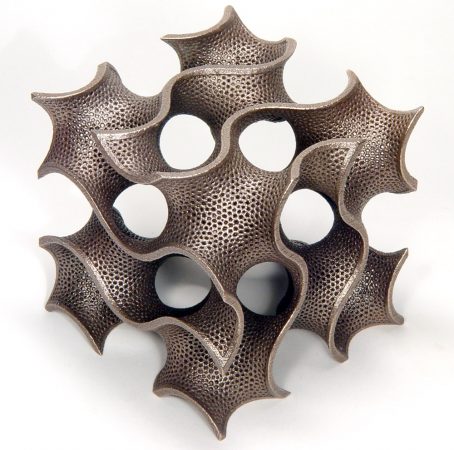
Grossman believes most successful artists have a “secret weapon” — a technique, style or subject matter that makes their work instantly identifiable. Grossman’s secret weapon? Geometry. “It’s been a shock to me and everybody else to discover that there is this hunger for geometry out there,” she says. “People don’t get enough geometry in their daily lives. I think I’ve started a movement!”
Pulling back the veil
Most magicians thrive on secrecy. Their illusions deliberately distract or mislead the audience. Arthur Benjamin, a self-taught “mathemagician,” is just the opposite. “The goal of my presentation is not for the audience to see how smart I am, but how smart they can be.”
Benjamin begins his magic act with a few tricks to hook the audience’s attention. He might multiply two numbers in his head faster than can a calculator. Or maybe he will create magic squares, sort of a mathematician’s super Sudoku in which the numbers in each row, column and diagonal add up to the same total. Soon, he drops the veil of secrecy and starts explaining his tricks. He also answers audience questions, such as “What is your favorite number?” (It’s 2,520. Want to know why? The explanation is at the bottom of this story.)
By day, Benjamin teaches mathematics at Harvey Mudd College in Claremont, Calif. Mathemagic is his whole second career. He performs 50 to 60 times a year, including a week or two of shows at the Magic Castle, a world-famous magic club in Hollywood, Calif. Since 1990, he has performed close to 1,000 times at the Magic Castle alone. Benjamin also has appeared on television’s The Colbert Report and The Today Show. And of course he is a big hit on the Internet: One performance has received more than 4 million hits.
Even as a child, Benjamin was a showman. He took to magic in junior high school. Before long, he was performing a mix of card, number and memory tricks as “The Great Benjamini.”
While Benjamin was in college, he met James “The Amazing” Randi. Randi is a magician who has made a career of exposing fakes. He quickly recognized that Benjamin’s ability to perform great feats of mental arithmetic was genuine. So Randi urged him to show people the real magic behind mathematics. That advice changed Benjamin’s life.
“My show is like arithmetic on steroids,” Benjamin says. “And that’s good. Math starts with arithmetic. Getting people excited about that is the first step in helping them become proficient.”
Among the people Benjamin has inspired is a teen from Connecticut named Ethan Brown. A few years ago, when Ethan was just 10, he watched the most wildly popular of Benjamin’s online videos. He then bought Benjamin’s book, Secrets of Mental Math. Ethan soon started teaching himself Benjamin’s tricks. Today, he performs his own mathemagic act.
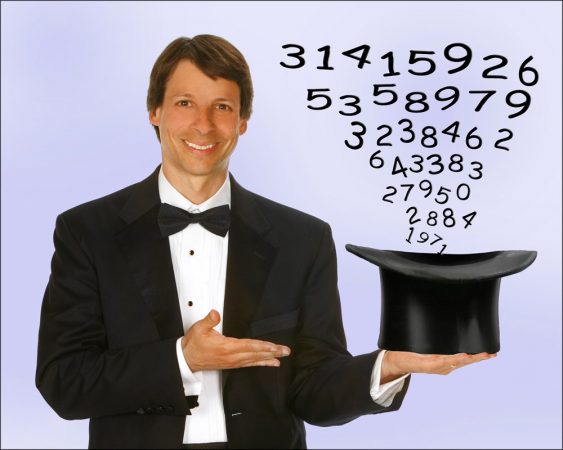
Ethan has since invented a magic-square trick that not even Benjamin can do. The boy asks three people in an audience to each choose a number from 1 through 20, and to write their chosen numbers anywhere in a four-by-four square. After entering three more numbers of his own, Ethan asks the audience what the numbers in each row and column should total. And then, Benjamin marvels, Brown quickly fills in all of the remaining squares so they add up to that total.
Benjamin is excited about his young protégé. “I’m delighted to pass along the methods and the idea of math as entertainment to the next generation,” he says. The two even performed together in November 2012 at a conference in New Delhi, India. Look for another viral video hit!
(Oh, and Benjamin likes 2,520 because it is the smallest number divisible by all the numbers between 1 and 10. Try it yourself!)
Power Words
rebar Short for reinforcing bar. A steel rod used internally in concrete structures to give them additional strength.
minimal surface A surface similar to soap film that uses less material than any other surface with the same boundary.
octahedron A three-dimensional shape that has eight plane surfaces.
equation In mathematics, the statement that two quantities are equal. In geometry, equations are often used to determine the shape of a curve or surface.
geometry The mathematical study of shapes, especially points, lines, planes, curves and surfaces
magic square A grid divided into smaller squares, each containing a number. The figures in each row, column and diagonal must add up to the same value.
symmetry In geometry, the property of being indistinguishable from a shifted, rotated or reflected image of the same object. For example, the letter X looks the same whether reflected in a mirror or turned upside down — two different kinds of symmetry.
physics The science that describes how physical objects respond to forces.
engineering The science that uses physics to design things to perform specific functions in anticipated ways, such as cars, telephones and computers.
gravity The force that pulls all objects toward Earth. (When you weigh yourself, you are actually measuring the force of gravity on you.)
pixel Short for picture element. A tiny area of illumination on a computer screen, or a dot on a printed page, usually placed in an array to form a digital image.
Word Find (click here to print puzzle)
This is one in a series on careers in science, technology, engineering and mathematics made possible by support from the Northrop Grumman Foundation.
